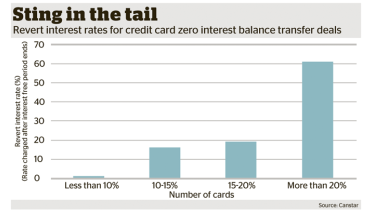Beware sting in zero per cent credit card deals - SMH - Clancy Yeates January 22, 2016
Here are some of the traps in banks' zero interest credit card offers.
Banks are trying to re-ignite credit card spending by tempting consumers with an array of "zero per cent" balance transfer offers.
The number of these deals – which allow customers to shift their balance to a rival and not pay any interest on that amount for a limited period – has near doubled in the past two years.
If you've racked up a large credit card debt, the zero per cent balance transfer deals look tempting.
f you've got a sizeable credit card debt, these can look appealing. But before being tempted by the prospect of paying no interest for a year or more, consumers should be aware of a few big traps.
Interest rate comparison website Canstar says there are a record 97 balance transfer offers being promoted, up from 56 two years ago. Most of these will allow you to pay no interest on your balance for at least 12 months.
No interest for a year – what could go wrong, right? Well, plenty.
If you're not disciplined about paying off the balance before the end of the period, any savings you've made can quickly be gobbled up by very high interest rates.
Canstar analyst James Slack explains that a key trap to look out for is the high interest rate that customers will be slugged with if they don't pay off the full amount before the zero per cent period ends.
About two thirds of cards covered by Canstar offering balance transfer deals revert to an interest rate of 20 per cent or more, as the graph shows. Only one card reverts to an interest rate of less than 10 per cent.
"For people who don't pay off a balance transfer within the interest free period, the revert rate could cost them a lot in interest charges," Slack says.
Choice calls these revert rates the "sting in the tail". And let's face it – plenty of people don't pay off their balance in time, despite the best of intentions.
It's also worth remembering that the "zero per cent" interest only covers the balance you bring across, not new purchases, which will often be charged interest at a much higher rate.
Some cards charge a "balance transfer fee" which might be 2 to 3 per cent of the amount you are transferring. Others have an annual fee to consider.
Given all these costs and potential risks, some blame balance transfer offers for putting customers into more debt than they can afford, prompting a recent inquiry to recommend tighter restrictions on their use.
The Australian Securities and Investments Commission told a Senate inquiry last year that "behavioural biases" meant many overly optimistic consumers took up these deals, even though they were likely to pay the much higher interest rates.
The committee concluded that while some disciplined customers can end up better off from balance transfers, these deals could also become a "debt trap" for others.
In response to these risks, the senators called for tougher rules requiring banks to tell their customers when their interest-free period was about to end.
For now though, it's up to consumers to weigh up the risks before being tempted by a balance transfer deal.
